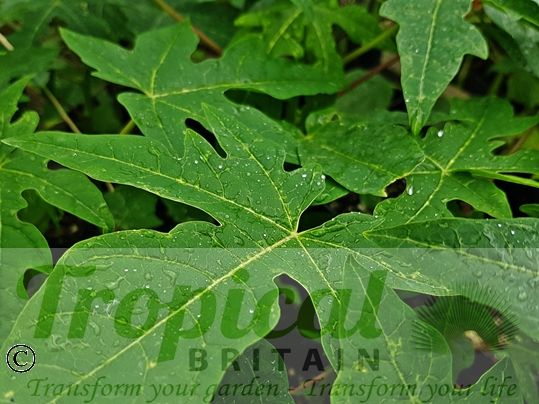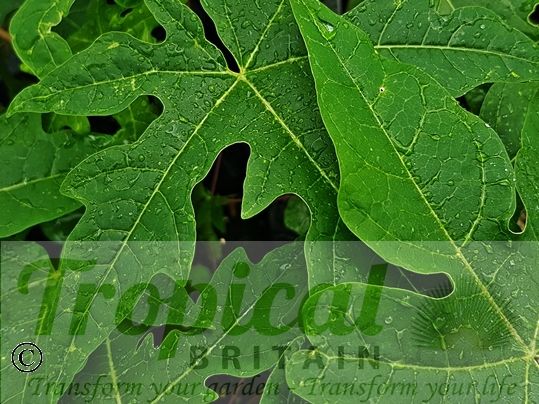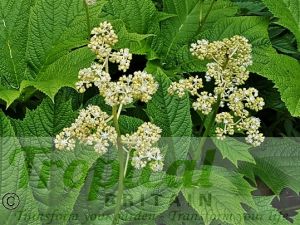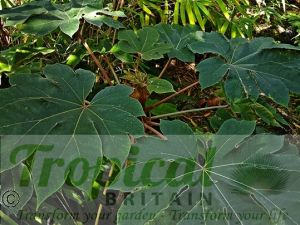Carica papaya, Papaya, the tropical tree that bears the familiar fruit of the same name originates in Central America and Northern South America. It is now a mono-specific genus after all the other species were transferred to other genera, mostly Vasconcellea. A quick-growing plant, Carica papaya rapidly forms a sculptural exotic specimen - the epitome of the tropical look - with large, lobed, umbrella-like leaves and a tall central stem. Grown throughout the tropics for its fruit and commonly grown outdoors in warm temperate climates like New Zealand, it is very frost-sensitive and in the UK and Northern Europe must be brought indoors for the winter. Although it is unlikely your plant will form edible fruit, half the fun of growing it is to try. It's fun to grow it even as an annual bedding plant and at the very least you have a rapidly-growing exotic ornamental for your jungle.
Outdoors in the summer it needs a warm sheltered aspect with full sun or partial shade and a rich fertile soil. It does not like standing water around its roots and the soil must be well-drained. Bring indoors in early October and house in a frost-free environment gradually reducing its water intake as it adjusts to the lower light levels and cooler drier atmosphere. Keep it as humid as possible but stop watering it altogether in the coldest darkest months. If it gets too cold indoors or too dark it will probably lose its leaves. This tendency to defoliate is relatively common as it struggles with adjusting to the new conditions. It can often also experience transplanting setback so growing it in as large a container as you can manage is useful. The container can be taken outdoors again once all danger of frost has passed - from May to early June depending on your location.
Additional Information
| Order | Brassicales |
|---|---|
| Family | Caricaceae |
| Synonyms | Carica bourgeaui, Carica citriformis, Carica citriformis, Carica cubensis, Carica hermaphrodita, Carica jamaicensis, Carica jimenezii, Carica mamaya, Carica papaya var. bady, Carica papaya f. correae, Carica papaya f. ernstii, Carica papaya var. jimenezii, Carica papaya f. mamaya, Carica papaya f. portoricensis, Carica peltata, Carica pinnatifida, Carica portoricensis, Carica posopora, Carica pyriformis, Carica rochefortii, Carica sativa, Papaya bourgeaei, Papaya cimarrona, Papaya citriformis, Papaya communis, Papaya cubensis, Papaya cucumerina, Papaya edulis, Papaya edulis var. macrocarpa, Papaya edulis var. pyriformis, Papaya hermaphrodita, Papaya papaya, Papaya peltata, Papaya pyriformis, Papaya rochefortii, Papaya sativa, Papaya vulgaris, Vasconcellea peltata |
| Geographical Origin | Central America, Northern South America |
| Cultivation | Full sun or partial shade. Warm sheltered position. Rich, well-drained fertile soil. Must be over-wintered indoors in the UK. Sparse watering during winter |
| Eventual Height | 2-3m |
| Eventual Spread | 1-2m |
| Hardiness | Tender. Sensitive to even a light frost. Must be brought indoors and overwintered in a frost-free environment |
-
I adore it.My mother grew a papaya from seed when I was a child and I'd always intended to get one since.
This was the only plant that didn't travel too well and I hear they are notoriously dissatisfied by root disturbance and being moved.
It took two days of TLC and shedding the lower leaves for it to straighten out and strengthen up.
Two weeks later and the leaves are fleshy, there's growth from the crown and there are sprouts appearing on the lower part of the trunk, exciting. It seems a fast grower.
The leaves are absolutely gorgeous and oh so tropical. A real beauty, which will live in my outbuilding with me and grow however big it likes to!
Posted on

Free DELIVERY
ON ALL ORDERS OVER £99THIS OFFER IS VALID ON ALL OUR STORE ITEMS.














